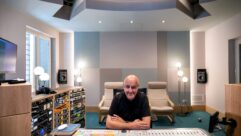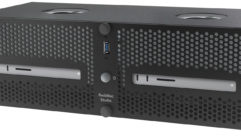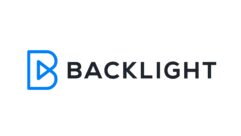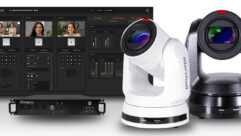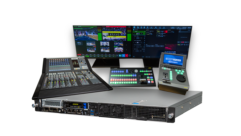

Studio Flexibility at WHYY in Philly
The new studio at a public broadcaster’s media commons reflects the perfect marriage of AV and building infrastructure.
The studio at WHYY’s Dorrance H. Hamilton Public Media Commons has its own dedicated control room with a Broadcast Pix Slate 1000 production system. Feeds from the studio go from here to WHYY’s operations center.
CHALLENGE: Design a multifunctional studio–usable by staff and the public–that can act as a broadcast studio, lecture hall, classroom, or movie theater by doing little more than rearranging chairs.
SOLUTION: Install a pair of sound systems to give the room versatility; integrate them with a DSP and a control system for push-button changes; then plug all the AV into an all-digital, high-performance network that can make content accessible outside the studio’s–and the building’s–walls.
It’s true that good things come to those who wait. And wait. About 13 years ago, Rich Coluzzi, president of RJC Designs in Glen Burnie, Md., was approached by public broadcaster WHYY in Philadelphia to begin work on a new media annex to the organization’s downtown headquarters. Over the intervening years, discussions and program development continued slowly while WHYY dealt with issues of zoning, parking, and all-important fundraising.
Although RJC Designs had started envisioning how it would design the AV systems for the new facility, the delay turned out to be a good thing. “We wanted to be as future-proof as possible,” Coluzzi says. “Technology advanced far enough that some of the things we envisioned 13 years ago are now possible.”
Bill Weber, WHYY’s technical director throughout the process, is glad that the project followed the path it did. “It’s good that we waited because technology changes rapidly.”
The new building, designed by KSS Architects of Philadelphia and christened last September as the Dorrance H. Hamilton Public Media Commons, added 8,000 square feet to WHYY’s existing 60,000 square feet of office and studio space. (WHYY also took about 4,000 square feet of existing space, rennovated it, and integrated it with the commons.) It was created to be a place where anyone interested in media could learn about, enjoy, and ultimately create their own audio, video, multimedia, and other projects. The Public Media Commons offers youth programs, community classes, and professional-development instruction. And at the heart of it, taking up more than half the new space, is the Lincoln Financial Digital Education Studio.
The studio was designed to serve a variety of purposes. It’s a presentation space, for lectures and panel discussions. It’s a theater, with a rear-projection display and a surround-sound audio system. And it’s a broadcast studio, capable of hosting any of WHYY’s broadcast TV programs and tied directly to the station’s main technical operations center through the studio’s dedicated control room.
Because potential users would have diverse needs, the AV systems needed to accommodate them, beginning with the studio’s sound system. RJC Designs determined that no single audio infrastructure could adequately deliver the optimal experience for all users. So the AV consultant engineered two systems for the same space.
The first audio system is for speech reinforcement. RJC Designs specified, and AV integrator Vistacom installed, 12 Community Professional iBox i2W8T loudspeakers from a ceiling grid above the studio floor. There is also a pair of Community M12-BP floor monitors, which can be used as audio fold-back or as front-fill speakers for live broadcast, presentations, or town-hall-style meetings. All the reinforcement speakers are configured through a Biamp AudiaFlex digital signal processor and powered by multizone Crown Audio amplifiers.
The second audio system handles surround sound and conventional program audio when the studio is used to host films and other presentations. It’s built around a 16-by-9-foot Draper Cineglass rear-projection screen and includes various other Community iBox models. “Though we tried to make that room as flexible as possible, you have to have a front of the room,” Coluzzi says.
For surround sound, a pair of iBox iHP3594 three-way mains are built into the wall on each side of the video screen. Two i2W8 two-way surround speakers hang from the rear of the ceiling grid. A Community iBox i215LVS subwoofer is recessed within the wall off stage right.
The center-channel speaker, however, proved to be a challenge. “We couldn’t recess the center channel into the screen wall because of structural issues,” Coluzzi says. “Typically we want the center channel to be mounted above or below the screen for localization reasons. However, due to a structural beam directly above the screen, we couldn’t recess or mount it at the desired location.”
ADJUSTING TO THE BUILDING
The designers knew they’d need rear-projection from the outset–a Digital Projection dVision 30-1080p XL. At any time, WHYY could roll in HD video cameras and fire up the high-brightness studio lights–also hanging from the ceiling grid–and wash out a front-projection system. But the building’s support structure affected studio’s front wall and its surround-sound system.
“We originally wanted the screen to be 61/2 feet off the floor, but about a foot off the top of the screen is a big steel beam,” Coluzzi says. The original plan would have accommodated a 16-inch riser in front of the screen and still give seated participants an unobstructed view. But because of the beam, the screen had to be lowered 1-1/2 feet. The riser was customized and reduced a few inches to help achieve the desired results with the new screen location, but even that didn’t solve all the structure-related issues.
In the rear-projection room, the structural beam was right at the upper limit of the projected image. RJC Designs performed careful calculations to determine projector placement. In the final placement, the upper projected image just cleared the beam by 4 inches. The consultants then turned their attention to the center-channel loudspeaker. “We had just enough room to get the screen in,” Coluzzi says. “But we didn’t have enough height to recess anything.”
This meant hanging the center channel from the grid, about 4 feet in front of the screen–not an ideal situation, but one that could be handled successfully. “When you move that speaker that far away from where the image is, you start having dispersion problems,” Coluzzi says.
At the time, Community was developing a wide-dispersion version of the iBox, says John Loufik, a senior applications engineer at the company. “When we were working with RJC it was a custom design,” he says. “We were working on a cabinet with a 120-degree-by-60-degree pattern that would cover the center area well.” The result: Community’ two-way iBox iHP1226 loudspeaker, which would eventually become a standard offering in the iBox line.
Coluzzi says that the beauty of the surround-sound system is the way it also handles stereo audio. “Obviously there is program material that’s not surround sound,” he says. “And in some surround-sound systems, stereo audio just doesn’t sound very good, either because the system isn’t designed for it or the equalization isn’t accommodating. For whatever acoustical or sonic reason, when you go from a surround-sound system to a standard stereo system, it’s just terrible.”
Loufik worked with the AV team during commissioning in order to optimize the system’s performance under both surround-sound and stereo conditions. “There were times when we’d switch between the two modes and we didn’t even notice until we got to an effect in the audio,” he says.
Studio Flexibility at WHYY in Philly
The new studio at a public broadcaster’s media commons reflects the perfect marriage of AV and building infrastructure.
The speech reinforcement and program audio/surround-sound are tied into an AMX control system and accessible via the operators’ AMX console and a wireless AMX panel. From an AMX Modero touch panel, studio users can choose one of four basic setups. In talking with WHYY’s technical people, event management, and the architect, RJC Designs recognized that 95 percent of the time, the room was going to be set up in one of the four ways.
FINE-TUNING THE AUDIO
The studio at WHYY’s Dorrance H. Hamilton Public Media Commons has its own dedicated control room with a Broadcast Pix Slate 1000 production system. Feeds from the studio go from here to WHYY’s operations center.
Even though there are four presets, WHYY’s technical staff can fine-tune the systems as they see fit. “Because of the way we designed the audio matrix and routing system, if we needed to get some speech reinforcement into the front speakers in the wall, we could,” Coluzzi says. “And if we needed to get some program audio, like from a computer or a DVD, into the speakers up in the grid, we could.”
In fact, the 12 speech reinforcement speakers firing down from the ceiling grid are programmed as 12 zones, which gives operators tremendous flexibility. For example, if WHYY hosts a panel discussion at the front of the room, and if the speakers in the front zones start to feed into the presenters’ mics, operators can turn off the first row of speakers. Alternately, WHYY may want to rotate the studio’s seating 90 degrees to face a presenter standing beneath a pair of hanging NEC displays. If the presenter wanted to show a video, the program audio–which, under normal circumstances, would come out of the speakers in the front wall–can be rerouted to the speakers over the audience’s heads.
AN ALL-DIGITAL INFRASTRUCTURE
As the heart of the Public Media Commons, the studio is linked bidirectionally through a dedicated control room to the rest of the facility, including two community classrooms and a conference room. The classrooms function as an extension of the studio: Students can engage in events taking place in the studio or make presentations to studio guests.
The studio is also connected to WHYY’s technical operations center, from which broadcasts that originate in the studio can be uploaded to satellites, or presentations can be fed into WHYY’s existing videoconferencing codecs for sharing over long distances. The Public Media Commons is based on an all-digital HD-SDI infrastructure, which allows compatibility with fixed and broadcast cameras, displays, and other technologies throughout the studio, control room, and the rest of WHYY. “It was critical that this room be compatible with the rest of WHYY’s technology,” says Kevin Opeth, project design engineer for RJC Designs.
Inside the studio, there are tie lines (HD-SDI, communications, fiber, Cat-6, and specialized camera/intercom feeds) on all four walls both for local control room connections and connectivity to the operations center. Microphone connectivity and line-level feeds are sent from the studio to the control room, where they are split to a SoundCraft mixer and then sent via CobraNet to the operations center.
While the Public Media Commons is all-digital, it wasn’t always going to be that way. In the classrooms, for example, the original design called for a smattering of analog connections. But even those connections were soon replaced by DVI and HDMI, creating end-to-end digital distribution systems.
“Keeping up with the digital evolution during the design process was a challenge. Format and device compatibility, HDCP issues, EDID, cable distances, digital equalization, etc., were all issues that needed concentrated technical and expert attention,” Opeth says. “There is no gray area in the digital domain.”
EQUIPMENT LIST
Below is a partial list of the equipment specified by RJC Designs and installed in the new Lincoln Financial Digital Education Studio at the Dorrance H. Hamilton Public Media Commons in Philadelphia.
- AMX NetLinx control system
- AMX MVP-8400 Modero ViewPoint touch panel
- AMX NXT-1500VG Modero tabletop touch panel
- Biamp AudiaFlex digital signal processor
- Broadcast Pix Slate 1000
- 4 Chief PCMU ceiling mounts
- 12 Community Professional iBox i2W8T speakers
- 2 Community Professional iBox i2W8 speakers
- 2 Community Professional iBox iHP3594 installation speakers
- Custom Community Professional iBox iHP1226 center speaker
- Community Professional iBox i215LVS subwoofer
- 2 Community Professional M12-BP stage monitors
- Crown Audio CTs 4200 power amplifier (speech reinforcement)
- Crown Audio CTs 8200 power amplifier (speech reinforcement)
- Digital Projection dVision 30-1080p XL
- Custom 16-by-9-foot Draper Cineglass rear-projection Cinescreen
- Extron MDA 3V distribution amplifier
- 6 Extron MDA 4V HD-SDI four-output SDI distribution amplifiers
- Extron SSP 7.1 surround-sound processor
- 4 Lectrosonics LMa digital hybrid UHF beltpack transmitters
- 2 Lectrosonics UT digital hybrid wireless handheld transmitters
- 6 Lectrosonics Venue VRS receiver modules
- Lectrosonics VRM WB Venue wideband receiver
- Marshall Electronics V-R72P-2HD HD-SDI monitor
- Marshall Electronics V-R72DP-2C dual-screen analog composite PAL/NTSC monitor
- 2 Middle Atlantic Products WRK-44-27 racks
- 2 Middle Atlantic Products MPR-8 modular raceways
- 2 Middle Atlantic Products MPR-SEQ modular sequencers
- 8 Middle Atlantic Products RLM-20 power modules
- 2 NEC MultiSync P401 monitors
- 2 NEC MultiSync LCD195WXM-BK monitors
- 4 NEC MultiSync 52-inch LCD5220-AV pro displays
- 6 NEC SB-L007KK HD-SDI input cards
- QSC Audio PLX1802 power amplifier (surround system)
- 2 QSC Audio PLX3102 power amplifiers (surround system)
- Shure SCM810 8-channel microphone mixer
- 6 Shure SM58 vocal microphones
- Sierra Video Ponderosa 48×48 HD-SDI routing switcher
- 3 Sony BRCZ700 high-defi nition PTZ video cameras
- 3 Sony BRBK-HSD1 HD-SDI output cards
- Soundcraft Si3 audio console
- TOA Electronics A-712 integrated mixer and amplifier
- 5 TV One 1T-C2-520 DVI-I to SD/HD-SDI converters
- 5 TV One IT-C2-511 SD/HD-SDI to DVI-I converters
- 4 TV One C2-2355A HD up-down-cross converters
Source: RJC Designs


